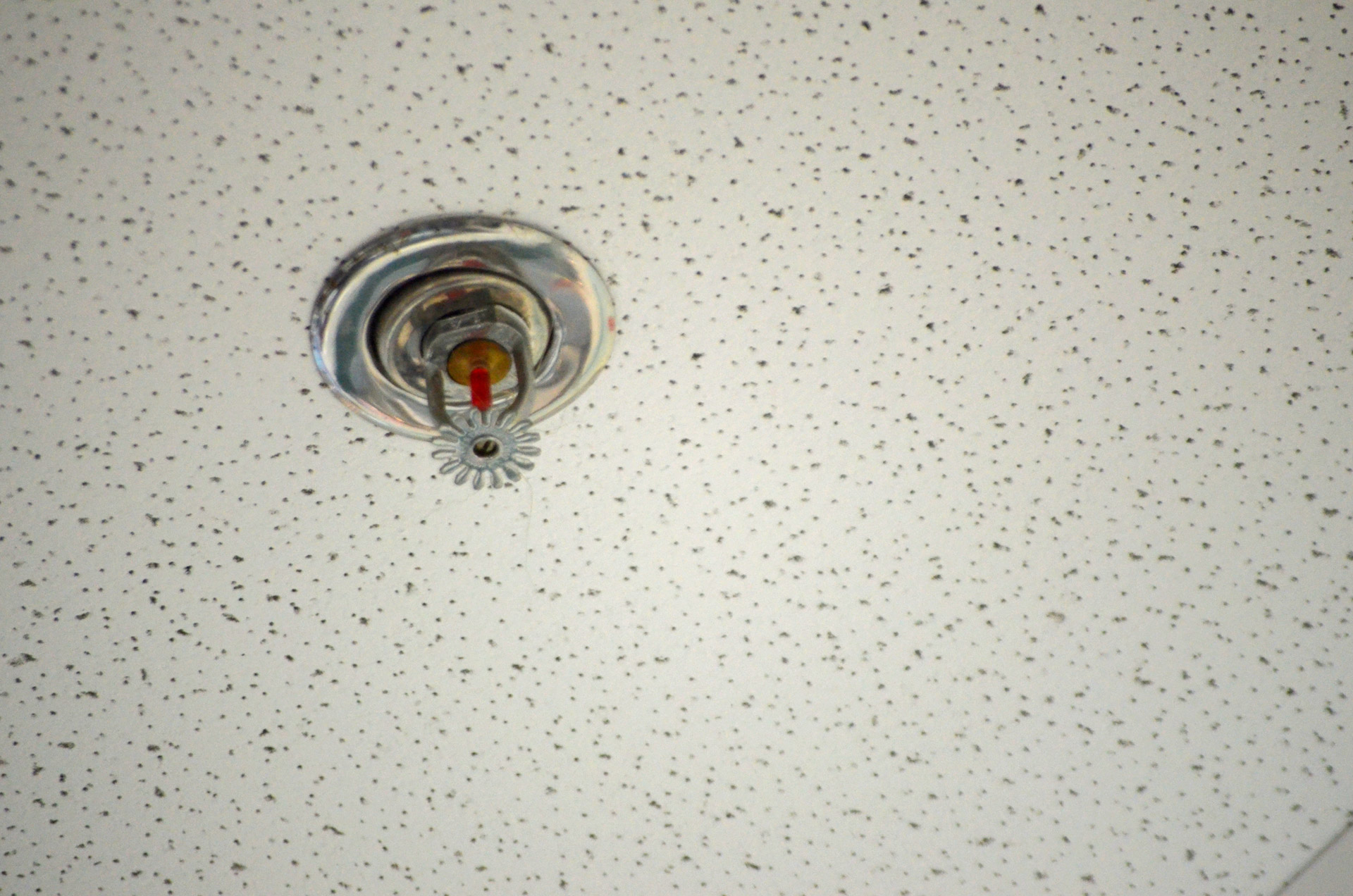Sprinkler head
Contents |
[edit] Introduction
An automatic sprinkler system consists of a water supply (tank, pump and valves) and sprinkler installation (pipes and heads). Almost all buildings over 30m high must be fitted with a sprinkler system installed in accordance with the appropriate British Standards.
The specification of the design depends primarily on the hazard classification of the occupancy of the building. The specifications include head spacing dimensions, assumed area of maximum operation (number of heads in-operation), design density (water discharge), water supply period and tank volume.
[edit] How do sprinkler heads work?
Sprinkler heads are heat sensitive devices that consist of a plug, a glass ampule or other trigger mechanism, deflector, cap and frame.
The system’s heat sensitive element can be constructed from soldered links or glass bulbs containing various liquids. Some sprinkler head ampules contain a mixture of alcohol and water or glycerin and water. When hot air reaches the ceiling, this liquid expands, causing the container to break and activate the sprinkler head so it can distribute water and extinguish the fire.
Sprinkler heads normally activate at 68°C. Each sprinkler head acts as its own heat detector and only those in the area of the fire will be activated. An individual sprinkler head typically covers 9m².
The flow of water from the sprinkler head is generally distributed by a flower-shaped deflector device directly below the sprinkler. This shape is designed to control the flow of the water so it is evenly distributed.
[edit] Sprinkler head variations
There are quick response (QR) fire sprinkler heads which have a smaller ampule so they can activate in a shorter period of time. These devices typically distribute water across the ceiling or down walls as a method of controlling fire by preventing it from rising.
QR sprinkler heads tend to be used in places where many people may be present and life safety is a priority.
Standard response sprinkler heads tend to be used in facilities where there is a greater need to protect the contents of a building.
There are several different sprinkler head orientation options. The most common are:
- Pendant heads use a convex deflector to distribute water in a domed or conical pattern.
- Upright heads spray water upwards to a concave deflector, producing a dome-shaped spray pattern.
- Sidewall heads have a semicircular deflector that produces a crescent-shaped spray pattern.
- Concealed heads are pendant or sidewall sprinkler heads that have been covered with a fire sprinkler cover plate. This cover lowers when a certain temperature has been reached. The fire sprinkler head is then revealed so it is able to activate.
[edit] Related articles on Designing Buildings Wiki
Featured articles and news
RTPI leader to become new CIOB Chief Executive Officer
Dr Victoria Hills MRTPI, FICE to take over after Caroline Gumble’s departure.
Social and affordable housing, a long term plan for delivery
The “Delivering a Decade of Renewal for Social and Affordable Housing” strategy sets out future path.
A change to adoptive architecture
Effects of global weather warming on architectural detailing, material choice and human interaction.
The proposed publicly owned and backed subsidiary of Homes England, to facilitate new homes.
How big is the problem and what can we do to mitigate the effects?
Overheating guidance and tools for building designers
A number of cool guides to help with the heat.
The UK's Modern Industrial Strategy: A 10 year plan
Previous consultation criticism, current key elements and general support with some persisting reservations.
Building Safety Regulator reforms
New roles, new staff and a new fast track service pave the way for a single construction regulator.
Architectural Technologist CPDs and Communications
CIAT CPD… and how you can do it!
Cooling centres and cool spaces
Managing extreme heat in cities by directing the public to places for heat stress relief and water sources.
Winter gardens: A brief history and warm variations
Extending the season with glass in different forms and terms.
Restoring Great Yarmouth's Winter Gardens
Transforming one of the least sustainable constructions imaginable.
Construction Skills Mission Board launch sector drive
Newly formed government and industry collaboration set strategy for recruiting an additional 100,000 construction workers a year.
New Architects Code comes into effect in September 2025
ARB Architects Code of Conduct and Practice available with ongoing consultation regarding guidance.
Welsh Skills Body (Medr) launches ambitious plan
The new skills body brings together funding and regulation of tertiary education and research for the devolved nation.
Paul Gandy FCIOB announced as next CIOB President
Former Tilbury Douglas CEO takes helm.
UK Infrastructure: A 10 Year Strategy. In brief with reactions
With the National Infrastructure and Service Transformation Authority (NISTA).























